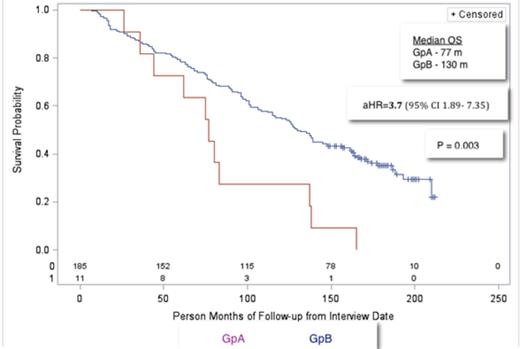Abstract
Introduction:
Monoclonal gammopathy of unknown significance (MGUS) is present in 2.4% of general population of age 50 years or older. Monoclonal gammopathy of renal significance (MGRS) is defined as subjects with MGUS, and renal insufficiency who demonstrate monoclonal immunoglobulin deposits in kidney biopsy by immunofluorescence in abscess on any other cause. As renal biopsy is not routinely indicated in the individuals with MGUS, we defined clinical MGRS (cMGRS) as subjects with renal insufficiency without obvious reason except MGUS itself. As there is very little known about cMGRS in literature our aim of this study is to determine the prevalence of cMGRS in MGUS population, and to compare the survival of cMGRS with rest of MGUS individuals.
Methods:
Data is obtained from NHANES III, a nationally representative health survey conducted from 1988-1994 with follow-up mortality data updated in December 2006. Subjects who were diagnosed with MGUS were included in the study. They were divided into two groups; Group A (GpA)(cMGRS) subjects with serum creatinine of ≥1.5 mg/dL and without any apparent reason for renal insufficiency and group B (GpB) comprising rest of MGUS subjects with Serum creatinine < 1.5 mg/dL or ≥1.5 mg/dL with a known cause of renal insufficiency, particularly diabetes, hypertension, or lupus. Prevalence of MGUS and MGRS was analyzed using chi-square test. Median overall survival between two groups was obtained using Kaplan Meier curve. Age adjusted hazard ratio for death between two groups was obtained using cox-proportional regression model. The p-value <0.05 was considered statistically significant in the analysis. Analyses were performed in SAS 9.3 (SAS Institute, Cary NC).
Results:
Of 33,994 subjects in the NHANES III database, 6574 subjects age 50 yrs or older were screened for MGUS with serum protein electrophoresis. Of those, 320 subjects had abnormal protein band or equivocal results. After further evaluation by immunofixation studies, 196 subjects had MGUS. The median age of subjects was 71 yrs, 62% (121) were males and 38% (75) females. Median follow-up was 127 months. There were 11 subjects in GpA and 185 in GpB. The weighted prevalence of MGUS is 2.4%(95% CI 1.9-2.9). Among the MGUS subjects 6%( 95%CI 0.01-13) were classified as cMGRS. Median overall survival was 77 months for GpA and 130 months for GpB (p= 0.003)(fig 1). The age adjusted hazard ratio (aHR) showed a significant increase in the risk of death in GpA with aHR 3.7 (95% CI 1.89- 7.35) compared to GpB.
Conclusion:
The prevalence of clinical MGRS is 6% among MGUS subjects in NHANES III. Subjects with clinical MGRS had worse survival and higher risk for death compared to rest of MGUS subjects. Further prospective studies are needed to validate our findings and to investigate whether clinical MGRS subjects need an early intervention than current standard management of watchful-waiting.
No relevant conflicts of interest to declare.
Author notes
Asterisk with author names denotes non-ASH members.


This feature is available to Subscribers Only
Sign In or Create an Account Close Modal